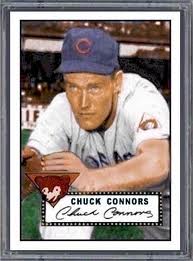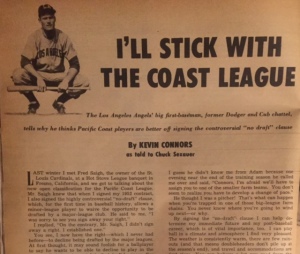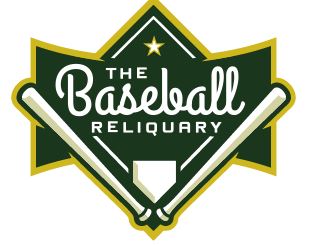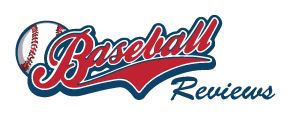When Kevin Joseph Connors was growing up in Brooklyn he dreamed of someday taking the field for his hometown Dodgers. If he was like most boys at the time, he also probably dreamed of being a cowboy. Little did Kevin know that he would live both dreams – and then some.
In his lifetime, Connors would take to:
- the court under the tutelage of Basketball Hall of Famer John Russell;
- the diamond alongside Baseball Hall of Famer Tommy Lasorda; and
- the movie set across from Academy Award winner Spencer Tracy.
If you are old enough to be aware of Kevin Connors, you may know him better by his nickname “Chuck” – or as star of the successful TV western series The Rifleman. You may also recall him in such classic movies as Old Yeller or for his appearances in television presentations like Roots (which earned Connors an Emmy nomination).
 But this is a baseball blog, so why all this attention to an actor? To answer that, we need to go back to Connors’ boyhood dream of playing for his beloved Dodgers. Connors made that dream come true – if only for a single pinch-hitting appearance. (And, what would most baseball fans give for even just one at bat with our favorite team – and one line in the Baseball Encyclopedia?)
But this is a baseball blog, so why all this attention to an actor? To answer that, we need to go back to Connors’ boyhood dream of playing for his beloved Dodgers. Connors made that dream come true – if only for a single pinch-hitting appearance. (And, what would most baseball fans give for even just one at bat with our favorite team – and one line in the Baseball Encyclopedia?)
Connors also went on to play first base for the Chicago Cubs, forward and center for the Boston Celtics, be drafted by the Chicago Bears and earn his way into the National Cowboy Hall of Fame – now the Western Performers Hall of Fame of the National Cowboy and Western Heritage Museum.
The most compelling reason BBRT is taking a look at Chuck Connors, however, is that (as NBA Hoops Online notes) Connors is one of only twelve players to play in both the National Basketball Association and Major League Baseball – and BBRT has a significant interest in multi-sport athletes.
For a look at BBRT’s favorite multi-sport athletes click here. You’ll read about:
– Deion Sanders – the only player to hit a major league home run and score an NFL touchdown in the same week;
– Gene Conley – the only player to play on a World Series winner and an NBA champion;
– Bo Jackson – selected as an MLB All Star and NFL Pro Bowler in the same year;
– Carroll Hardy – who pinch hit for Ted Williams, Roger Maris and Carl Yastrzemski and scored four NFL touchdowns as a receiver; and
– 17 more multi-sport achievers.
Connors signed with his beloved Dodgers in 1940, right out of high school. After a one-for-eleven start for the Class D Newport Dodgers, Connors decided accepting a baseball scholarship to Seton Hall University might be a wiser course of action. At Seton Hall, the six-foot five-inch Connors played baseball and basketball and, in what would later prove extremely important to his future, got hooked on the performing arts.
Connors went back to the professional ranks in 1942, signing with the Yankees and playing one season for the Class B Norfolk Tars. Later that same year, he enlisted in the Army and served stateside until early 1946 (playing semi-pro basketball in his free time). After his discharge from the Army, Connors joined the Rochester Royals of the National Basketball League, playing in 14 games before returning to the Yankees, who put him on waivers during 1946 Spring Training. To Connors’delight, his hometown Dodgers picked up his waivers and sent him to Newport News, where he emerged as a power-hitting first-base prospect – leading the Class B Piedmont League with 17 home runs. In the fall of that year, Connors added to his athletic resume by signing with the Boston Celtics of the Basketball Association of America (soon to merge with the NBL to form the today’s National Basketball Association). He played just two seasons with the Celtics – averaging 4.5 points per game.
Between 1946 and 1949, Connors moved up the minor league baseball ladder – from the B level Newport News Dodgers (1946) to the AA Mobile Bears (1947) to the AAA Montreal Royals (1948-1949). Notably, Connors proved a decent player – and somewhat of a good luck charm. Each of the teams he played on from 1946 to 1949 ended up as league playoff champions. Over those four minor seasons, Connors played in 544 games, compiling a .293 average with 69 home runs.
Connors’ dream of playing for the Dodgers came true at Ebbets Field on May 1, 1949 – when he was called off the bench to pinch hit for Brooklyn right fielder Carl Furillo (who would go on to hit .322 with 18 homers and 106 RBI that season). With one out in the bottom of the ninth, Gil Hodges on first and the Dodgers trailing the Phillies 4-2, Connors hit into a pitcher-to short-to-first double play to end the game.
It wasn’t long afterwards, that Connors found himself back in Montreal, where he finished the season hitting .290, with six home runs, 68 RBI and a surprising 14 stolen bases. Despite his love for the Dodgers, Connors realized Gil Hodges was firmly entrenched at first base and requested a trade. The Dodgers complied and dispatched him to the Cubs. The Cubs sent Connors to their Pacific Coast League farm club, the Los Angeles Angels, where a strong start to the 1951 season (.321 with 22 home runs, 77 RBI and eight steals) made him a fan favorite – and earned him a mid-season call-up to Chicago, where he hit just .239 with two home runs and 18 RBI in 66 games.
Through all of his athletic endeavors, Connors was a showman (or in some people’s eyes a showboat). In a May 1951 Sport Life magazine article, Connors was described as “part-comedian, part-time first baseman and all character.” He was also known as a hotel lobby magician and a great banquet speaker renowned for his dramatic recital of “Casey at the Bat”).
Connors’ flair for the dramatic – on and off the field – did not go unnoticed by the show business crowd that often attended Angels games. In fact, in the fall of 1951, one of Connors’ Los Angeles fans tapped the good-looking first baseman for another kind of performance. Bill Grady, an executive with Metro-Goldwyn-Meyer, asked Connors to do a screen test for a small part in the film Pat and Mike (starring Katherine Hepburn and Spencer Tracy). Connors got the part and a new career was born. In an acting career that stretched into the 1990s, Connors – probably most remembered for his role as Lucas McCain in the popular Rifleman television series – appeared in more than 40 movies and a host of television series and specials.

Connors made his preference for the Pacific Coast League known in a July 1952 Sport magazine article,
Connors recognized his good fortune and always maintained his greatest break as a ballplayer came in 1951, when the Cubs sent him to Los Angeles – putting him “right out in the middle of the movie business.” He saw significant enough potential in acting that when he agreed to his 1952 baseball contract, he signed a then available clause that allowed minor leaguers to waive the opportunity to be drafted by a major league club. In an article for Sport Magazine, he extolled the west coast earnings opportunities, the weather, and the Pacific Coast League’s salaries, playing conditions and travel accommodations. In the closing paragraphs of that article, Connors said, “I live in my own home in the San Fernando Valley the year round. I can play golf and go fishing everyday if I want to. I’m two hours from ski country, 20 minutes from good swimming, two-and-a-half hours from a bull fight. I’m near many lucrative income sources. Do I want to be drafted away from all this … Not me.”
As anyone reading or watching might have predicted, Connors left baseball in 1953 to pursue his acting career – and the rest is history.
A few Connors’ tidbits:
– In 1959, Connors won a Golden Globe Award (Best Television Performers) for his work in The Rifleman.
– Connors starred in four television series: The Rifleman; Arrest and Trial; Branded; and Cowboy in Africa.
– In 1984, Connors was honored with a “star” on Hollywood’s Walk of Fame.
– In a four-season span at AAA (1948-51), Connors’ batting averages were: .307; .319; .290 and .321.
– In 1966, Connors brought his baseball past and his Hollywood present together, serving as an intermediary credited with ending the much-publicized holdout of Dodgers’ star pitchers Sandy Koufax and Don Drysdale.
– Connors was known to turn cartwheels while circling the bases after a home run.
– Connors made guest appearances on television shows ranging from Gunsmoke to Spenser for Hire to the Sonny & Cher Comedy Hour.
– Connors’ movie credits include such films as Pat and Mike; Old Yeller; Geronimo, Flipper; The Big Country; Solyent Green; and Airplane II.
– Connors is credited with shattering the first glass backboard ever, during a November 1946 Celtics’ pregame warm-up.
One final Connors story, this one shared on the “Our Chuck Connors” website … ourchuckconnors.com
After a 1946 appearance – reciting Casey at the Bat – representing the Celtics at the Boston Baseball Writers Dinner, Connors was approached by Ted Williams who told him: “Kid, I don’t know what kind of basketball player you are, but you ought to give it up and be an actor.”
Teddy Ballgame always did have a good eye.







Did Chuck Connors ever recorded Casey at the bat and is it available on the Internet